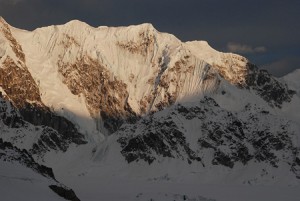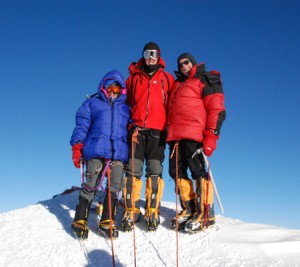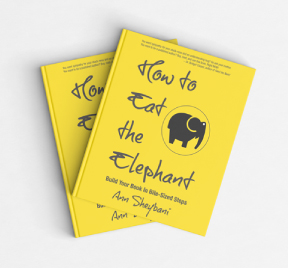Writing
Relentless Pursuit of a Dream
May 13, 2011
This is a guest post by Walt Hampton. A beautiful example of how one book can alter the course of a life.
It had been a warm summer day in August of 1972. My father had purchased the book for me that morning in a Nantucket bookshop, the book that would change and shape my life: Art Davidson’s Minus 148.
What a captivating, gripping tale. The story of the first winter ascent of Mt. McKinley. Think about it: climbing in the Arctic in the dead of winter. Only a few hours of dim light each day. Unpredictable, ferocious storms. Sustained hurricane force winds. And temperatures that dropped to 148 degrees below zero. Uninhabitable. Unsustainable. Untenable.
I was mesmerized by the courage, the bravery, the audacity, the daring. I longed to explore McKinley’s slopes: to walk the sweeping Kahiltna, to round Windy Corner, to climb the steep slopes to Denali Pass, to traverse beneath the Archdeacon’s Tower, and to stand at last at the highest point in North America.
For days that summer, it was all I could think about. And at the tender age of 14, I made a promise to myself: I too would be an audacious explorer. I too would climb Denali.
When I returned home from Nantucket that summer long ago, I began climbing rocks along road cuts: I fancied them Yosemite big walls, or perhaps the Eiger. I read stories of Yvon Chouinard and Royal Robbins. I was a free soloist! But uneducated, unroped, I returned day after day battered and bruised. Yet surprisingly alive.
I don’t know why my parents never forbade this ridiculous obsession. Instead, my father, either through wisdom or curiosity, insisted that we go together to learn how to do this “thing” properly. And so we went together to the venerable Palisades School of Mountaineering in Big Pine, California. We learned rock climbing and glacier travel, rope management, safety skills, and team building. My dad and me: how good is that!
Later, we would go together to the Adirondack Mountain Club’s winter mountaineering school. We would climb in the ‘Daks and share epics and near epics in the Whites. Every week we would go to the crags. But the mountains always called to us the loudest. We would test our mettle in the brutal winter on Mt. Washington and ski the headwall on Tuckerman Ravine.
But always, I would imagine myself on The High One.
College and graduate school intervened. A young family. Babies. Tuitions. Mortgage. Bills. Responsibilities.
Climbing dropped by the wayside. No time to train. No time to travel. No partner who shared the interest.
My dream of Denali dimmed. It would lurk just beneath the surface: I would hear it call to me in a bookstore or as I passed a magazine rack or as I stumbled over my tangled Goldline rope in the corner of the garage.
In my last year of law school, I had the opportunity to teach an ice-climbing course. And although I had never ice climbed, the experience reignited my passion and rekindled the hope that maybe, just maybe, I might still climb in the big mountains of the world.
In my early thirties, I set Denali once again squarely in my sights. I honed my skills and updated my equipment. I began to exercise and run again. I became a hard-core winter camper. I did a winter traverse of Franconia Ridge and then stepped up for the New England test piece: a winter traverse of the Presidentials. Feeling confident, I climbed Rainier. And then I deemed myself “ready.”
When I landed on the Kahiltna in May of 1996, I was blown away. Not literally. At least not in that moment. But nothing, absolutely nothing, had prepared me for the scale, the massive scale, of the Alaska Range. It was mind-bending.
I was immediately confronted with the death of two young climbers who had fallen below Denali Pass. The helicopter carrying their bodies flew low overhead as we began our trek from base camp. Hours later, a teammate would collapse in status seizures and nearly die. Surviving through the night, we evacuated him on a Chinook in the face of an oncoming storm.
For three days, it snowed. Five feet in six hours one night. The avalanches cascaded and echoed through the nearby Valley of Death. The wind blew relentlessly and up high, camps were destroyed. A friend of mine from North Conway leading another expedition barely escaped with his life and the lives of his clients when their tents blew apart in the storm. (He never again returned to high altitude guiding.)
At the 11,000′ camp, a Korean climber was found dead in his tent, the victim of carbon monoxide poisoning. Or a stroke.
At 14,000′, two Koreans became lost in a whiteout and died of exposure. The rangers dragged their frozen bodies past my tent and stacked the body bags neatly alongside their outpost.
I gazed up at the fixed lines rising 900′ above the basin. And I was overcome with terror.
There was such beauty. Such magnificence. Such grandeur. And exhausting carries, devastatingly heavy loads, overwhelming fatigue. And death. Everywhere.
I had four children at home. A wife. A career. And my father’s admonition echoing in my head: there are old mountaineers and bold mountaineers but few old bold mountaineers.
The mountain would always be there, he would say. I turned tail and went home.
Fear won that day. Round one.
I would later rationalize that I didn’t really need to climb Denali. It had been a foolish dream. Something responsible career-minded folks, like me, didn’t do. Certainly it would not be something that I would ever be silly enough to try again.
I returned home. Everyone seemed pleased that I had learned my lesson.
What I didn’t immediately realize was how profoundly Denali had worked on me. I had been infected: The place had lodged in my heart.
I didn’t immediately realize either how radically the experience had changed me: I became more deliberate, more tolerant, more peaceful. More aware of beauty and diversity. More connected to the Earth.
I began to read more, reflect more, become more connected with my own spirituality. I began to meditate.
Others didn’t understand – couldn’t understand – what had happened to me. And I certainly couldn’t explain it. For me there were no words.
Unknown to me, a tectonic plate had shifted. Somewhere in the bitter arctic cold, my life had forever shifted.
I became restless. I changed paths in my career. My marriage disintegrated.
And a longing quietly grew in my heart: to return to The High One.
It would be years before I acknowledged the longing. Indeed, I openly denied that I would ever go back to Denali.
For a while, I didn’t even climb. The lessons had been too brutal, too harsh, too overwhelming. Too frightening.
Of course, the High One cared not of these things. And the mountains always call us back.
A friend asked if I would consider leading a trip to Aconcagua. Aconcagua? It sounded like a spider or an illness. I had to go to the books to read about it: the highest mountain in the Western Hemisphere, higher than Denali, but not as cold, not as technical. South of the boarder, in an exotic place. I said yes.
After my success on Aconcagua, I was inspired to push forward with my wilderness medical and leadership skills. I guided trips to the volcanoes of Ecuador. I climbed the volcanoes of Mexico. I explored the Cascades. I played for countless summers in the Tetons.
The mountains had become my home again.
As my father had done for me, I introduced my boys to climbing. They loved the high mountains. And I loved those moments that allowed me to pay forward the gifts I had received.
And miracle of miracles, after a dozen years as a single dad, I met the love of my life: an athlete, a marathoner, a lover of the outdoors and adventure; intelligent, talented, passionate, beautiful, and funny; courageous, audacious, and fit. She loved gear! And of course she would like to explore this thing called climbing! I couldn’t believe my luck!
Off we went together, sometimes alone and sometimes with our children: into the cold and snow; and to high and wild places. We enjoyed a glorious trip to Africa and summited Kilimanjaro. We explored Moscow and St. Petersburg and climbed Elbrus.
And suddenly, without warning, it seemed to make sense again; it seemed to be time again. I heard the siren call again: The High One.
All of the old fears rose up. How would I feel standing in that place again? Would I overcome the demons of fear and failure that still haunted me?
For the ten months before our expedition, Ann and I trained vigorously: long runs, brutal carries, heavy loads, weights at the gym, packs on the Stairmaster. Trips in the snow and cold to test our gear. And our resolve.
On summit day, early in May, 2009, the winds blew hard. As we stood beneath Pig Hill, after 18 days of climbing, we could see sheets of snow sheering off the summit ridge. We could see that it was not our day.
And the tears flowed hard.
I looked over my shoulder as we flew from the Kahiltna. I had turned 52; I had shared my rope – and my dream – with my life’s partner in the most magnificent place I could ever imagine; but the summit eluded me again.
I gave it my best shot, I said. It was a spectacular adventure – what more could I ask for, I thought. There are other mountains, other places. Yes, time to move on. I was done with Denali. We talked of summer things. Different projects. Other ranges.
Six weeks passed. And in the dark, at night, I could hear her call again: The High One.
She wouldn’t let me go. At least not easily.
On June 27, 2010, on a crystal clear windless night at 9:00 p.m., under the midnight sun, Ann and I stood on the summit of Denali with our son.
I looked down at the Football Field below me where I had once wept, across the Archdeacon’s Tower, down toward Denali Pass. I could see the glistening river of the Kahiltna stretching for miles in the falling shadows and the vastness of the Alaska Range spread before me. I looked across the years, the decades of this dream. And felt such joy.
I thanked my father in the silence of my heart for the gift of the mountains that he had given me. And for that little book that changed my life.
I hugged my son and held my wife. And started home.
In the dark, I still hear her call. She always will.
I smile. She knows I will return.
To learn more about Walt, visit his blog at http://www.journeysontheedge.net
Look for his upcoming book, Journeys on the Edge: Living a Life That Matters.







